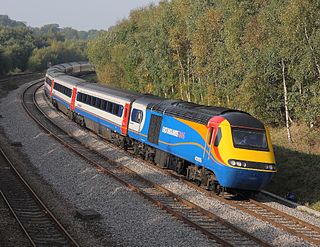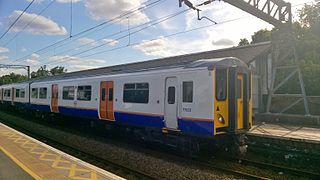
The Midland Main Line is a major railway line in England from London to Sheffield in the north of England. The line is under the Network Rail description of Route 19; it comprises the lines from London's St Pancras station via Leicester, Derby/Nottingham and Chesterfield in the East Midlands.

Crossrail is a 73-mile (117-kilometre) railway line under development in England that crosses London from east to west. At each end of the central core, the line will divide into two branches: in the west to Reading and stations at Heathrow Airport, and in the east to Abbey Wood and Shenfield. In May 2015, a section of one of the eastern branches, between Liverpool Street and Shenfield, was transferred to TfL Rail; this precursor service also took control of Heathrow Connect in May 2018.

The North London line (NLL) is a railway line which passes through the inner suburbs of west, north west and north London, England between Richmond in the south-west and Stratford in the east, avoiding central London. Its route is a rough semicircle.

National Express East Anglia (NXEA) was a train operating company in England owned by National Express, that operated the Greater Anglia franchise from April 2004 until February 2012. Originally trading as One, it was rebranded National Express East Anglia in February 2008. It provided local, suburban and express services from London Liverpool Street to destinations in Essex, Hertfordshire, Cambridgeshire, Suffolk and Norfolk in the East of England.

The London, Tilbury and Southend Railway (LTSR), also known as Essex Thameside, is a commuter railway line on the British railway system which connects Fenchurch Street station in central London with destinations in east London and Essex, including Barking, Upminster, Basildon, Grays, Tilbury, Southend and Shoeburyness.

Northumberland Park railway station is on the Lea Valley line that forms part of the West Anglia Main Line, serving the ward of Northumberland Park in Tottenham, north London. It is 6 miles 73 chains (11.1 km) down the line from London Liverpool Street and is situated between Tottenham Hale and Angel Road. Its three-letter station code is NUM and it is in Travelcard zone 3.

The Lea Valley lines are two commuter lines and two branches in North East London, so named because they run along the Lower Lea Valley of the River Lea. They were part of the Great Eastern Railway, now part of the Anglia Route of Network Rail.

The West Anglia Main Line is one of the two main lines from Liverpool Street, the other being the Great Eastern Main Line to Ipswich and Norwich. It runs generally north through Cheshunt, Broxbourne, Harlow, Bishop's Stortford and Audley End to Cambridge, with branches serving Stratford, Hertford and Stansted Airport. The line runs along the boundary between Hertfordshire and Essex for much of its length.

The Braintree branch line is a railway branch line in the East of England that diverges from the Great Eastern Main Line at Witham and runs north-west to Braintree. The route is 6 miles 30 chains (10.3 km) in length and there are five stations, including the two termini. The line is part of Network Rail Strategic Route 7, SRS 07.06, and is classified as a London and South-East commuter line.

The Ely–Peterborough line is a railway line in England, linking East Anglia to the Midlands. It is a part of the Network Rail Strategic Route 5, SRS 05.07 and is classified as a secondary line. It is used by a variety of inter-regional and local passenger services from East Anglia to the West Midlands and North West, as well as freight and infrastructure traffic; it also links with the busy East Coast Main Line at its western end. Fenland District council put forward their Rail Development Strategy for the route in 2012, which includes infrastructure upgrades for the intermediate stations, improved frequencies for the services using it and establishing a Community Rail Partnership for the line in 2013/14.

Electrostar is the name given to a series of related electric multiple-unit (EMU) passenger trains manufactured by Bombardier Transportation at their Derby Litchurch Lane Works in England. Since the privatisation of British Rail, it has become the most common new EMU type in Britain, where different variants referred to as Class 357, Class 375, Class 376, Class 377, Class 378, Class 379 and Class 387, are most common on the high-volume suburban commuter routes in South, North and East London, and mainline services south to Surrey, Sussex, Kent & South Essex coasts and north to Cambridge and Stansted Airport. It shares the same bodyshell and core structure as the Turbostar, which is in turn the most common post-privatisation diesel multiple unit (DMU) family, and both evolved from the Class 168 Clubman design by ADtranz.

East West Rail is a major project to establish a strategic railway connecting East Anglia with Central, Southern and Western England. In particular, it plans to build a new line linking Oxford and Cambridge via Bicester, Milton Keynes and Bedford, largely using the trackbed of the former Varsity Line. Thus it provides a route between any or all of the Great Western, Chiltern, West Coast, Midland, East Coast, West Anglia and Great Eastern main lines, avoiding London. The new line will provide a route for potential new services between Southampton Central and Ipswich or Norwich via Reading, Didcot and Ely, using existing onward lines. The western section from Oxford to Bedford was approved by the government in November 2011, with completion of this section expected by 2025. As of January 2019, the Company aims to complete the Central section by "the mid 2020s". Electrification of the line is not planned.
The Freight Route Utilisation Strategy is a Route Utilisation Strategy in the United Kingdom, published by Network Rail in March 2007. It is one of only two which have the perspective of the network as whole. It was included in a map published by the Office of Rail Regulation (ORR) as established in May 2007. As with other RUSs, the Freight RUS took into account a number of responses to a Draft for Consultation, including those from the ORR.
The Scotland Route Utilisation Strategy is a Route Utilisation Strategy, published by Network Rail in March 2007, the third RUS to be published. The railways in Scotland are divided into three strategic routes, namely Route 24, Route 25 (Highlands) and Route 26 together with parts of Route 8 and Route 18. The three strategic routes form the scope of Network Rail's Scotland Route Utilisation Strategy. Separate RUSs for the ECML and WCML encompass the relevant parts of routes 8 and 18. The Edinburgh Crossrail service, which provides a direct route between Stirling, Dunblane and Bathgate in the west to Newcraighall in the east, operates over part of the ECML east of Edinburgh Waverley to Portobello Junction.
The Wales Route Utilisation Strategy is a Route Utilisation Strategy, published by Network Rail in November 2008. It was the tenth RUS to be produced. By default, RUSs are established by the Office of Rail Regulation (ORR) unless the latter objects within 60 days. A letter formally confirming establishment was sent by ORR to Network Rail in January 2009, and the RUS is included in Network Rail's map as established.
The Merseyside Route Utilisation Strategy is a Route Utilisation Strategy published by Network Rail in March 2009. It was the eleventh RUS to be produced. By default, RUSs are established by the Office of Rail Regulation (ORR) unless the latter objects within 60 days. The RUS is included in Network Rail's map as established.















